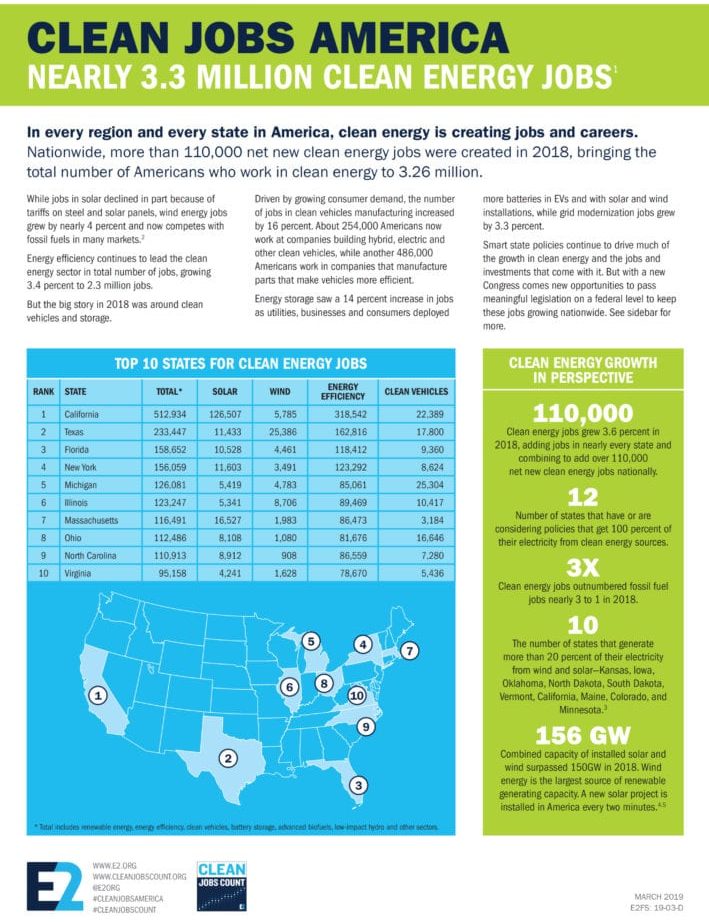*Industry now employs 2.3 million Americans; grew 3.4% in 2018
*28% of U.S. energy workers are employed by energy efficiency businesses
*Top 10 States: Calif., Texas, N.Y., Fla., Ill., N.C., Mass., Mich., Ohio, Va.
*EE employs 2X as many Americans as fossil fuel industries
LOS ANGELES – Energy efficiency is the fastest-growing segment of U.S. energy-sector employment, now employing more than 2.3 million Americans, according to a new analysis from E4TheFuture and the national, nonpartisan business group E2 (Environmental Entrepreneurs). Energy efficiency workers now account for 28% of all U.S. energy jobs.
The new report, Energy Efficiency Jobs in America, finds energy efficiency jobs grew 3.4 percent in 2018 –more than double the rate of growth for overall jobs nationwide — with 7.8% growth projected for 2019. Among the states, California leads energy-efficiency employment with 318,500 jobs, followed by Texas (162,800), New York (123,300), Florida (118,400), and Illinois (89,400). Thirteen states saw efficiency jobs increase by more than five percent in 2018, led by New Mexico (11.6%), Nevada (8.1%), Oklahoma (7.2%), Colorado (7.2%), and New Jersey (7.1%). Not a single state saw declines in energy efficiency employment in 2018.
The report, released at the annual meeting of the National Association of State Energy Officials (NASEO) in Manhattan Beach, California, highlights energy efficiency’s continued economic importance.
 “While politicians argue over the direction of our energy transition, the economic benefits of improving energy efficiency continue to unite America’s business and environmental interests,” said Pat Stanton, Director of Policy at E4TheFuture. “Not only is expanding America’s energy efficiency key to solving multiple climate policy goals, it is now integral to businesses’ expansion plans – saving money and creating local jobs that cannot be outsourced.”
“While politicians argue over the direction of our energy transition, the economic benefits of improving energy efficiency continue to unite America’s business and environmental interests,” said Pat Stanton, Director of Policy at E4TheFuture. “Not only is expanding America’s energy efficiency key to solving multiple climate policy goals, it is now integral to businesses’ expansion plans – saving money and creating local jobs that cannot be outsourced.”
Efficiency businesses added 76,000 net new jobs in 2018, accounting for half of all net jobs added by America’s energy sector (151,700). The sector also employed twice the number of workers in 2018 as all fossil fuel industries combined (1.18 million). There are now more than 360,000 energy efficiency businesses operating across the U.S.
“We all know energy efficiency saves consumers and businesses money with every month’s power bill,” said Bob Keefe, executive director of E2. “We should also remember that energy efficiency is creating jobs and driving economic growth in every state – and doing so while also helping our environment, not hurting it.”
Energy efficiency jobs include positions in manufacturing, such as building ENERGY STAR® appliances, efficient windows and doors and LED lighting systems. They include jobs in construction – retrofitting buildings, offices and schools to make them more efficient. Efficiency careers are found in high-tech design and software and professional services, as well as at the heating, ventilation and air conditioning (HVAC) companies that upgrade outdated inefficient HVAC systems, boilers, ductwork and other equipment.
Energy efficiency jobs aren’t limited by geography, geology or political persuasion. There are workers in energy efficiency in every state and in virtually every U.S. county, the report shows. More than 317,000 energy efficiency jobs are located in rural areas, while 928,000 jobs are found in the nation’s top 25 metro areas. In 41 states and the District of Columbia, more Americans now work in energy efficiency than fossil fuels.
“State energy officials understand that energy efficiency and the jobs that come with it is an integral and important part of the overall economy,” said David Terry, Executive Director at NASEO, which provides research support for the underlying data behind Energy Efficiency Jobs in America. “Policymakers at the state and federal levels will hopefully keep the size and reach of energy efficiency employment in mind as they plan for the future.”
More detailed findings of energy efficiency jobs for all 50 states and the District of Columbia – including job totals for every congressional and legislative district, industry and technology breakdowns, and maps of every state’s top counties — are at e2.org/eejobsamerica. A set of FAQs about the report is here.
Other key findings:
-10% of energy efficiency jobs are held by veterans — nearly double the national average of 6%
-Construction and manufacturing make up more than 70% of U.S. energy efficiency jobs
-More than one out of every six U.S. construction workers spend 50% or more of their time on energy efficiency (1.3 million workers)
-321,000 energy efficiency jobs are in manufacturing
-More than 1.1 million energy efficiency jobs are in heating, ventilation, and cooling technologies
-Efficient lighting technologies employ 370,000 workers
-ENERGY STAR appliances employ 167,000 workers
-Energy efficiency employers are projecting 7.8% job growth in 2019
-Small businesses are driving America’s energy efficiency job boom, with 79% of energy efficiency businesses employing fewer than 20 workers
-17 states employ more than 50,000 workers, and 40 states are home to at least 10,000 energy efficiency workers.
Ahead of Energy Efficiency Day 2019 on October 2, E2 and E4TheFuture will host an online panel discussion on Energy Efficiency Jobs in America 2019 featuring Keefe, Stanton, and the authors of the report from BW Research Partnership. To register and attend the free event on October 1, click here.
Energy Efficiency Jobs in America follows E2’s Clean Jobs America analysis, which found that clean energy jobs account for nearly 3.3 million jobs across all 50 states and the District of Columbia.
Both reports expand on data from the 2019 U.S. Energy and Employment Report (USEER) produced by the Energy Futures Initiative (EFI) in partnership with NASEO, using data collected and analyzed by BW Research Partnership.
The report was released in March, and is available at www.usenergyjobs.org. E2 and E4TheFuture were both partners on the USEER, the fourth installment of the energy survey first released by the Department of Energy in 2016 and subsequently abandoned under the Trump administration.



